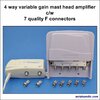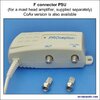Just moved and found one of these in the loft, connecting three tv leads (rooms) to the aerial. None work, however (the outlets), so I assume it's broken. If I connect the tv living room co-ax direct to the aerial and bypass the amp, the tv tunes and finds programmes fine, but no HD channels, so maybe the signal's a bit low (and also why someone thought an amplifier a good idea?)
So... Q1) Should these have a power supply? All that I've seen do.
Q2) Can anyone recommend a simple powered or non powered booster for a single (or perhaps two) tv setup?
Thank you!
View attachment 251266
If the picture you posted is the same as what you've actually got rather than just the nearest lookalike image, then you've got a phantom-powered 4-way amplified splitter with variable gain. These things need power to work. And I don't just mean some power so that 'boosting' works; I mean power so that any signal will pass through it. Without power you'll get diddly-squat from any of the outputs, so the guys here are correct.
The reason for installing something that uses a remote power supply with the voltage going up the cable is so that you don't have to have a 240V AC to DC transformer running 24/7 365 days a year that's neatly tucked away out of sight whilst living in a space that gets freezing cold in winter and boiling hot in summer. Some of us installers think that leaving something mains powered and unattended in such an environment isn't the best idea, particularly as a lot of this gear is made in China. I'm not suggesting that the amplifier manufacturing brands themselves would cut corners, but the subcontractors and their suppliers and their suppliers too.... Well, I'll leave you to draw your own conclusions.
Regarding HD signals, this could be a case of either the signal needing a lift from the splitter because the aerial is no longer a good match for the frequencies being transmitted, or maybe the local transmitter is one of the Light Service ones with limited HD.
The 'matching' thing is because of all the signal reshuffling to do with 4G and 5G. Over the past couple of decades an awful lot of folk had Wideband High-Gain aerials installed. These tuned from RF ch21 to ch68, but the highest gain was in the upper half of the frequency range; say ch40 to 68. Below ch40 the gain tailed off quite a bit. For someone in an area where the muxes were broadcast in the upper half of the range that was a really good fit. However, for the last dozen years or so the company responsible for the transmitters has been playing musical chairs with the frequencies for our muxes. This is because our Government wanted to sell off part of the TV frequency band for mobile phone use. It started with the sell-off to make space for 4G, so RF channels 60-68 went first. Then, more recently, the 5G sell-off means they rejigged again to sell off ch49 and above. The result is that the muxes are now in the lower half of the old ch21-68 range, and this is where those wideband high-gain aerials don't work quite as well.
For muxes broadcast on higher power levels and where the homes get a high field strength then they'll get by. Some folk though in more marginal areas could find they lose certain muxes when the conditions are not favourable. This is more likely to be the case where the mux frequency is on a low RF channel number.
The nature of digital means there's quite a fine line between the signal working okay and total loss. Changing the aerial could be the right thing to do in light of the new distribution.





